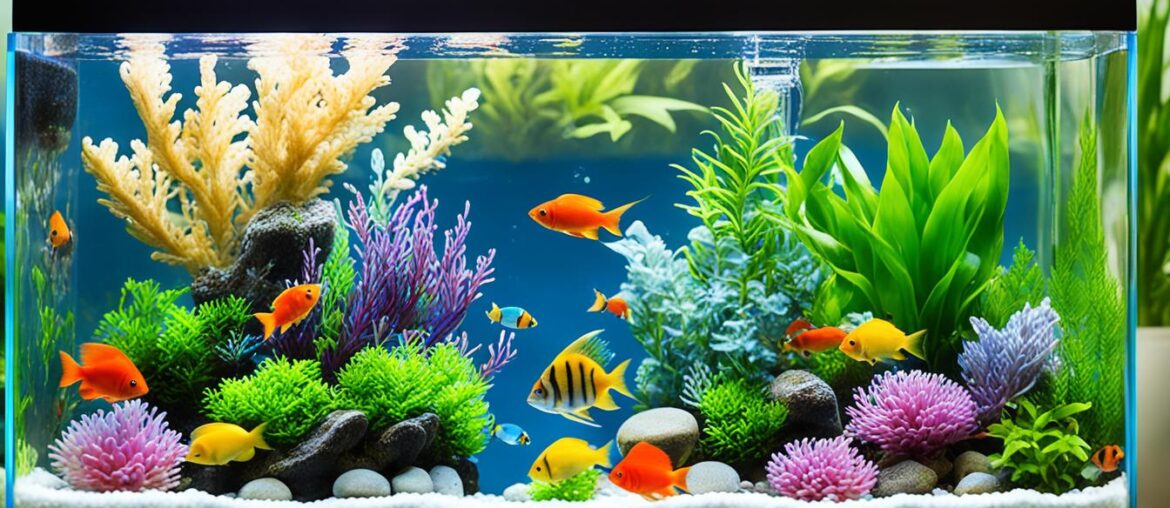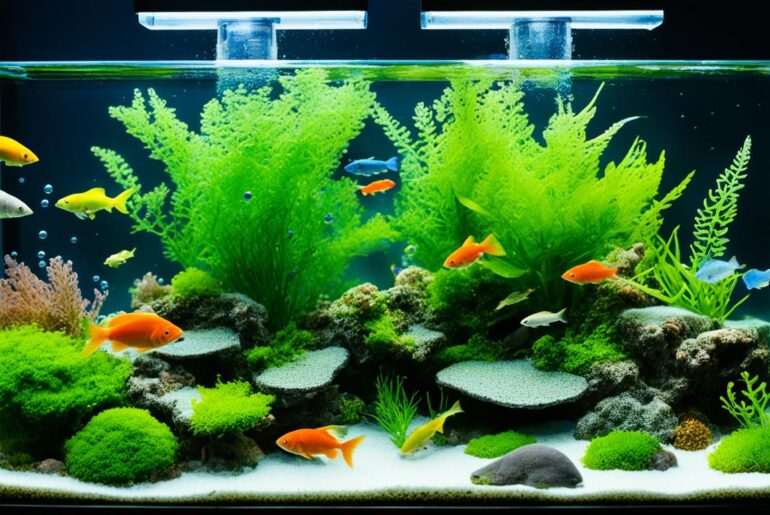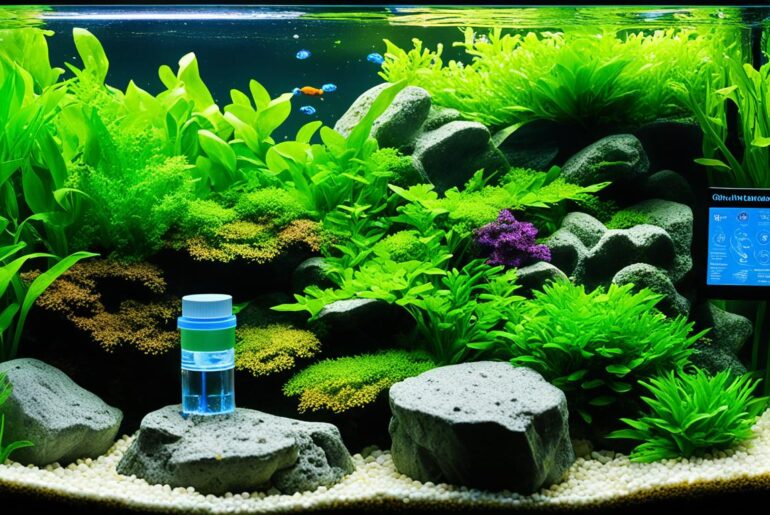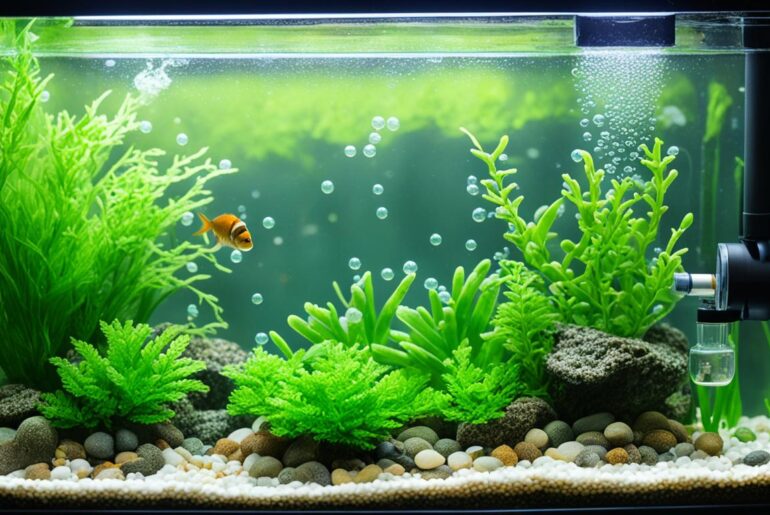Have you ever experienced the joy of setting up a new aquarium? The anticipation of adding vibrant fish to a stunning underwater world? I have, and let me tell you, it’s a magical feeling. But along with that excitement, I made some beginner mistakes that had unfortunate consequences for my fish.
When I first started my aquarium journey, I was filled with eagerness to create a thriving aquatic environment. However, I soon realized that there were crucial aspects I overlooked that could have prevented the hardships I faced. I learned the hard way that avoiding common mistakes in new aquarium cycling is vital to the well-being of our fishy friends.
Let me share with you the valuable lessons I learned, so you can avoid making the same mistakes I did. Implementing these three tips will help you establish a healthy and harmonious aquatic habitat right from the start.
Doing Proper Research Before Starting
One of the biggest mistakes beginners make when setting up a new aquarium is not conducting enough research beforehand. It’s essential to gather information about various aspects of aquarium setup, including tank size, equipment, water parameters, and fish species. By dedicating time to research, you can make informed decisions and set yourself up for success in creating a beautiful and thriving aquatic environment.
Proper research helps beginners avoid common mistakes and ensures a smooth journey into the world of aquarium keeping.
“Researching before starting is like setting the foundation of a sturdy aquarium. It allows you to understand the requirements of your fish and create an environment that will contribute to their health and happiness.”
– Marie Collins, Experienced Aquarist
When conducting research, here are some key areas to focus on:
- Tank Size: Understanding the appropriate tank size for the fish species you plan to keep is crucial. Different fish require different amounts of space to thrive. Researching the specific tank size requirements ensures that your fish have enough room to swim and flourish.
- Equipment: Familiarize yourself with the essential equipment needed for a successful aquarium setup. This includes filters, heaters, lighting, and water testing kits. Researching the best equipment options will help you make informed decisions and invest in reliable products.
- Water Parameters: Every fish species has specific water parameter requirements, including temperature, pH level, and water hardness. Researching these parameters and understanding how to maintain them within the appropriate range is essential for the health and wellbeing of your fish.
- Fish Species: Learn about different fish species and their compatibility with each other. Research their behavior, preferred tank conditions, and dietary needs. This knowledge will help you choose fish that can coexist harmoniously and thrive in your aquarium.
By conducting thorough research on these topics and seeking advice from experienced aquarists or reputable sources, you can avoid beginner mistakes and set up your aquarium with confidence.
| Common Mistake | Effect on the Aquarium | Solution |
|---|---|---|
| Not researching tank size requirements | Overcrowding fish, leading to stress and poor water quality | Research the adult size of fish species and provide an appropriate-sized tank. |
| Incorrect water parameter setup | Fish stress, illness, and even death | Research specific water parameter requirements for your chosen fish species and use appropriate water treatment products. |
| Choosing incompatible fish species | Aggression, stress, and potentially harmful interactions | Research the compatibility of different fish species and choose ones that can coexist peacefully in your aquarium. |
Conducting proper research before setting up your aquarium is a crucial step that will save you time, money, and the wellbeing of your fish. By gaining knowledge and understanding the essentials, you can create a thriving aquatic paradise for your underwater pets.
Avoiding Overstocking the Tank
Overstocking the tank is a common mistake that many beginners make when starting their aquarium journey. It’s essential to consider fish species compatibility and the capacity of your tank to ensure a healthy and thriving aquatic environment.
When it comes to fish species compatibility, each fish has unique needs and requirements. Some fish prefer to live alone, while others thrive in groups. It’s important to research and understand the behavior, size, and social needs of the fish you plan to keep. This knowledge will help you determine if certain fish can coexist peacefully in your tank.
Additionally, you need to consider the capacity of your tank in terms of its size and filtration capabilities. Overstocking can lead to numerous problems, such as poor water quality, increased stress on the fish, and a higher risk of diseases. By overloading the biological load of your tank, the filtration system may struggle to keep up, resulting in harmful ammonia and nitrite levels that can harm the fish.
It’s recommended to follow the general rule of thumb, which suggests keeping one inch of fish per gallon of water in your tank. However, this guideline is not foolproof, as some fish may have different space requirements and need larger tanks. Always research the specific needs of the fish you plan to keep and consult with experts to determine the appropriate number of fish for your tank.
“Properly establishing the right number of fish in your aquarium is crucial for creating a harmonious and healthy environment for your aquatic friends.”
By avoiding the mistake of overstocking the tank, you can ensure that your fish have ample space to swim and thrive. It also helps to maintain optimal water quality, reducing the likelihood of diseases and other health issues. Remember, a well-balanced and suitable population of fish leads to a beautiful and sustainable underwater ecosystem.
Fish Species Compatibility
| Fish Species | Compatibility |
|---|---|
| Guppies | Compatible with most peaceful community fish |
| Tetras | Compatible with other small, peaceful community fish |
| Angelfish | May be aggressive towards smaller or more timid fish |
| Gouramis | May be territorial towards similar or brightly colored fish |
| Corydoras Catfish | Compatible with most peaceful community fish |

Image: The image above highlights the importance of avoiding overstocking the tank, as it can lead to poor water quality and stress among the fish.
Properly Cycling the Tank
One of the most crucial steps in creating a healthy and thriving aquarium is properly cycling the tank. Unfortunately, many beginners overlook or underestimate the importance of this process. Cycling the tank is essential for establishing beneficial bacteria and ensuring a stable environment for your fish.
Cycling the tank involves the nitrogen cycle, which is a natural biological process that breaks down harmful ammonia into less toxic compounds. This process is facilitated by beneficial bacteria that colonize the aquarium surfaces.
When starting a new aquarium, it’s necessary to add a source of ammonia to kickstart the nitrogen cycle. This can be done using various methods, such as adding fish food, using ammonia drops, or using pure ammonia. The ammonia will then be converted into nitrite by nitrosomonas bacteria, and further converted into relatively harmless nitrate by nitrobacter bacteria.
Properly cycling the tank typically takes several weeks, as it allows time for the beneficial bacteria to multiply and establish a stable biological filter. It’s important to regularly test the water parameters during this process, including ammonia, nitrite, and nitrate levels, to ensure that they are within the appropriate range.
By cycling the tank before adding fish, you can prevent harmful ammonia and nitrite spikes, which can be fatal to fish. Cycling the tank also helps establish a healthy ecosystem where the fish can thrive. It’s important to be patient during this process and resist the temptation to add fish prematurely.
Remember: Properly cycling the tank is one of the most important steps in creating a successful aquarium. It ensures the establishment of beneficial bacteria, a stable biological filter, and a healthy environment for your fish. Take the time to cycle your tank properly, and you’ll be rewarded with a flourishing aquatic ecosystem.
The Nitrogen Cycle in a Fish Tank
| Stage | Description | Beneficial Bacteria |
|---|---|---|
| Ammonia | Waste products, uneaten food, and decaying organic matter produce ammonia, which is toxic to fish. | Nitrosomonas |
| Nitrite | Nitrosomonas bacteria convert ammonia into nitrite, which is still harmful to fish. | |
| Nitrate | Nitrobacter bacteria convert nitrite into nitrate, which is less toxic and can be managed through regular water changes. | Nitrobacter |
Regular Water Changes
Neglecting water changes is a common mistake that beginners make in aquarium maintenance. It’s crucial to understand the importance of regular water changes for maintaining a healthy and stable freshwater aquarium.
Water changes play a vital role in removing excess nutrients, waste, and pollutants from the water. Over time, these substances can accumulate and harm the fish, compromising their health and overall well-being. By neglecting water changes, you risk subjecting your fish to poor water quality, which can lead to various health issues.
To ensure good water quality and a healthy environment for your fish, it’s recommended to perform a 20% water change once a week, or more frequently if needed. Regular water changes help eliminate harmful substances, keeping the water clean and clear.
When performing water changes, it’s crucial to use a dechlorinator when adding new water. This helps remove harmful chemicals, such as chlorine and chloramines, ensuring the water is safe for your fish. Be mindful of the water temperature during water changes, as drastic temperature fluctuations can stress the fish. It’s best to match the temperature of the new water with that of the aquarium.

By incorporating regular water changes into your aquarium maintenance routine, you can maintain a clean and healthy environment for your fish. The benefits of regular water changes include:
- Improved water quality
- Reduction in excess nutrients
- Removal of waste and pollutants
- Enhanced fish health and well-being
“Regular water changes are essential for maintaining a healthy and thriving aquarium environment.” – [Your Name]
Monitoring Water Parameters
Aquarium water parameters play a crucial role in the overall health and well-being of your fish. As a beginner, it’s important to understand the significance of monitoring temperature, pH, and ammonia levels. By regularly checking and maintaining these parameters, you can create a stable and thriving aquatic environment for your fish.
Temperature
Temperature is one of the key factors that directly affects the comfort and health of your fish. Different fish species have specific temperature requirements, so it’s important to research the ideal temperature range for the fish you plan to keep. Use a reliable aquarium thermometer to monitor the water temperature daily.
pH Levels
pH level refers to the acidity or alkalinity of the water. Different fish species have different pH preferences, so it’s crucial to ensure that the pH level remains within the appropriate range. Regularly test the pH of your aquarium water using a pH testing kit or electronic meter. If necessary, make gradual adjustments to the pH level to avoid drastic changes that may stress or harm your fish.
Ammonia Levels
Ammonia is a toxic substance that can build up in the aquarium, especially in the early stages of tank setup and during the nitrogen cycle. Monitoring ammonia levels is essential to prevent its accumulation and protect your fish. Use an ammonia test kit to regularly check the ammonia levels in your aquarium. If ammonia levels rise, it indicates a potential issue with your tank’s filtration or the presence of excess waste. Take immediate action to address the problem and ensure the well-being of your fish.
“Regularly monitoring and maintaining proper water parameters is essential for the health and longevity of your aquarium ecosystem.”
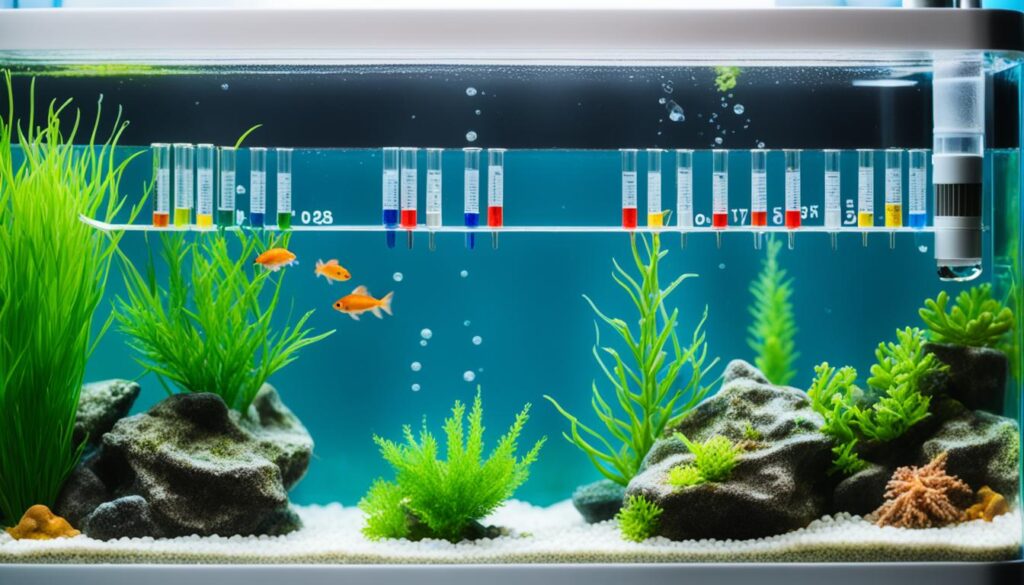
| Parameter | Ideal Range |
|---|---|
| Temperature | Depends on fish species |
| pH Level | Depends on fish species |
| Ammonia Levels | 0 ppm |
By closely monitoring and maintaining these water parameters, you can prevent potential issues, such as stress, disease, and even fish loss. Remember to conduct regular tests, record the results, and make any necessary adjustments gradually to provide a stable and healthy environment for your fish.
Avoiding Overfeeding
Overfeeding fish is one of the most common mistakes that beginners make when it comes to aquarium care. Feeding your fish the right amount of food is essential for their health and the overall well-being of your aquarium. Overfeeding can lead to poor water quality, which can have detrimental effects on your fish and the overall balance of your tank.
When it comes to feeding your fish, it’s important to consider their size and species. Different fish have different dietary requirements, so it’s crucial to provide them with a balanced diet that meets their nutritional needs. Providing the right amount of food is key to maintaining their health and avoiding any negative consequences.
One of the best practices for feeding fish is to offer them only as much food as they can consume within 30 seconds to a minute, once or twice a day. This ensures that they are getting enough nutrition without excess food accumulating in the tank. Remember, a quality diet is important, but so is maintaining good water quality by not overfeeding.
It’s worth mentioning that uneaten food can quickly deteriorate and contribute to the buildup of waste and debris in the tank. To prevent this, it’s crucial to remove any uneaten food from the tank after feeding. This helps maintain optimal water conditions and prevents the accumulation of harmful substances such as ammonia and nitrite.
| Benefits of Avoiding Overfeeding | Risks of Overfeeding |
|---|---|
|
|
By avoiding the common mistake of overfeeding, you can provide your fish with a healthy and balanced diet while maintaining optimal water quality in your aquarium. This will contribute to the overall well-being of your fish and create a thriving aquatic environment.
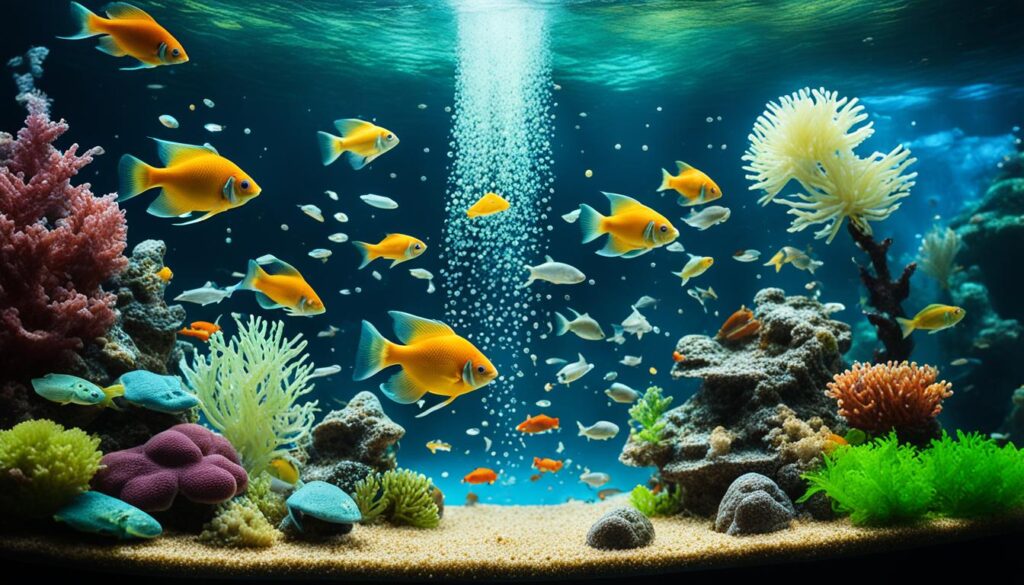
Avoiding Common Aquarium Keeping Mistakes
As an aquarium enthusiast, I understand the joy and satisfaction that comes with setting up and maintaining a beautiful underwater ecosystem. However, it’s important to be aware of and avoid common mistakes that can compromise the health and well-being of your fish. By practicing proper aquarium maintenance and following these guidelines, you can create a thriving environment for your aquatic pets.
Not Cycling the Tank
One of the most common beginner aquarium mistakes is neglecting to properly cycle the tank. The process of cycling involves establishing a stable biological filter to break down harmful substances like ammonia and nitrite. Without cycling, these substances can accumulate and harm your fish. To avoid this, take the time to cycle your tank before adding any fish. This can be done by adding a source of ammonia, such as fish food or ammonia solution, and allowing the beneficial bacteria to establish and convert ammonia into less harmful substances like nitrate.
Neglecting Water Changes
Regular water changes are crucial for maintaining a healthy aquarium. Over time, organic waste, excess nutrients, and pollutants can build up in the water, leading to poor water quality and stress on your fish. By neglecting water changes, you risk exposing your fish to harmful conditions. It’s recommended to perform a 20% water change once a week, or more frequently if necessary. Additionally, using a dechlorinator when adding new water helps remove harmful chemicals and maintain a safe environment for your fish.
Overfeeding the Fish
Overfeeding is a common mistake that can have detrimental effects on your fish’s health. It’s important to feed your fish the right amount of food for their size and species. Overfeeding not only leads to obesity and digestive issues but also contributes to poor water quality. Uneaten food can break down and release harmful substances into the water, impacting the overall health of your aquarium. Feed your fish only what they can consume within 30 seconds to a minute, once or twice a day, and remove any uneaten food promptly to maintain a clean and healthy environment.
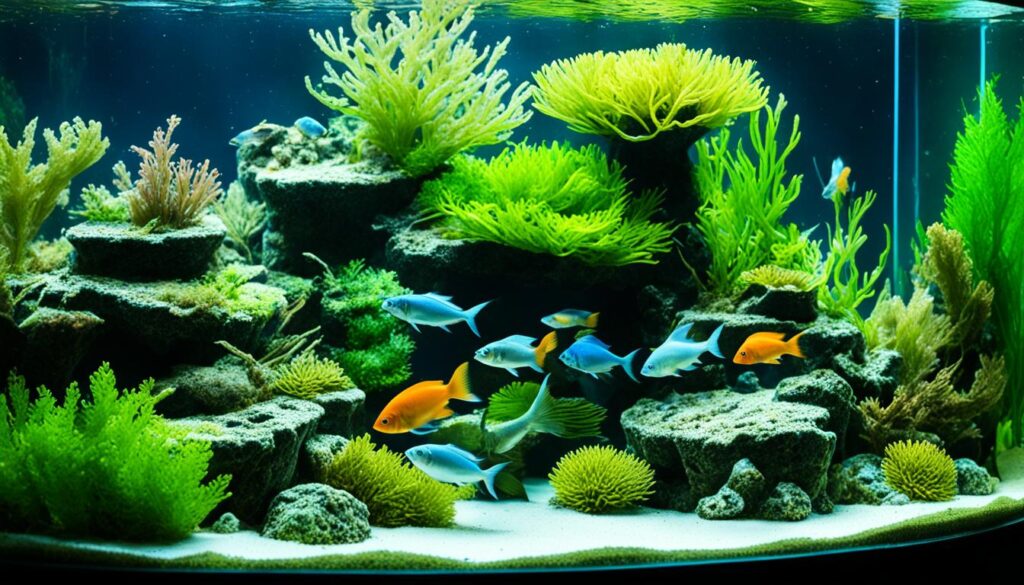
By being aware of these common aquarium keeping mistakes and implementing proper maintenance techniques, you can provide your fish with a safe and healthy habitat. Remember to cycle your tank, perform regular water changes, and feed your fish responsibly. Maintaining a balanced and well-maintained environment will ensure the longevity and well-being of your aquatic pets.
Conclusion
Avoiding mistakes in new aquarium cycling is crucial for creating a healthy and thriving aquatic environment. By conducting research, avoiding overstocking, properly cycling the tank, performing regular water changes, monitoring water parameters, and avoiding overfeeding, you can prevent common beginner mistakes and ensure the wellbeing of your fish.
Taking the time to educate yourself about the proper setup and maintenance of an aquarium is essential. Conducting research before starting will help you make informed decisions about tank size, equipment, and suitable fish species for your aquarium.
Properly cycling the tank is another important step that beginners often overlook. It establishes a stable biological filter by allowing beneficial bacteria to grow and break down waste. This helps maintain good water quality and prevents harmful ammonia and nitrite levels.
Regular water changes are necessary to remove excess nutrients, waste, and pollutants from the water. Monitoring water parameters such as temperature, pH, and ammonia levels is also crucial. By maintaining proper water parameters and avoiding overfeeding, you can create a stable and healthy environment that promotes the wellbeing of your fish.
Remember, a thriving aquarium is the result of careful planning, proper maintenance, and the avoidance of common beginner mistakes. By following these guidelines, you can create a beautiful and successful aquarium experience.
FAQ
What are some tips for avoiding common mistakes in new aquarium cycling?
3 Tips for avoiding common mistakes in new aquarium cycling include: doing proper research before starting, avoiding overstocking the tank, and properly cycling the tank.
Why is conducting research before starting an aquarium important?
Conducting research before starting an aquarium is crucial because it allows you to learn about tank size, equipment, water parameters, and fish species. This knowledge helps you make informed decisions and set yourself up for success in creating a beautiful and thriving aquatic environment.
What is the mistake of overstocking the tank?
Overstocking the tank is a common mistake beginners make. It can lead to poor water quality and increased stress on the fish. It’s important to research the specific needs of each fish species and determine how many fish your tank can comfortably accommodate to avoid this mistake.
What is the importance of properly cycling the tank?
Properly cycling the tank is essential for creating a healthy and thriving aquarium. It involves adding a source of ammonia and allowing it to break down over several weeks to establish a stable biological filter. By cycling the tank before adding fish, you can prevent harmful ammonia and nitrite levels and ensure a healthy aquatic environment.
Why are regular water changes important in maintaining a healthy aquarium?
Regular water changes are important for maintaining a healthy and stable freshwater aquarium. They help remove excess nutrients, waste, and pollutants from the water, which can harm the fish over time. It’s recommended to do a 20% water change once a week, or more frequently if needed, to ensure good water quality. Additionally, using a dechlorinator when adding new water helps remove harmful chemicals.
How should I monitor water parameters in my aquarium?
Monitoring water parameters is crucial for maintaining a healthy freshwater aquarium. Temperature, pH, and ammonia levels should be regularly checked to ensure they are within the appropriate range for your fish. Regular testing with a test kit or electronic meter is recommended. Any necessary adjustments should be made gradually to prevent sudden changes that could stress the fish.
Why is overfeeding fish a common mistake to avoid?
Overfeeding fish can lead to poor water quality and the accumulation of harmful ammonia and nitrite. It’s important to feed your fish the right amount of food for their size and species. Fish should be fed only as much as they can eat in 30 seconds to a minute, once or twice a day. Removing any uneaten food from the tank after feeding helps prevent debris buildup.
What are some common aquarium keeping mistakes to avoid?
Common aquarium keeping mistakes to avoid include not cycling the tank, neglecting water changes, overfeeding the fish, and not monitoring water parameters. By being aware of these mistakes and following proper aquarium maintenance practices, you can create a healthy and thriving environment for your fish.
Why is it important to avoid common mistakes in new aquarium cycling?
Avoiding mistakes in new aquarium cycling is crucial for creating a healthy and thriving aquatic environment. By following proper practices and avoiding beginner mistakes, you can ensure the wellbeing of your fish and create a beautiful and successful aquarium experience.
